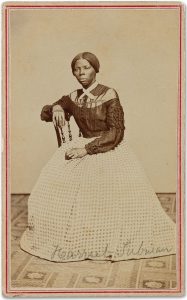After half a decade of back and forth, the U.S. government has once again announced its intention to place Harriet Tubman on the country’s $20 bill.
At a Jan. 26 press briefing, Jen Psaki, the press secretary for U.S. President Joe Biden, said the Treasury Department is “taking steps to resume efforts to put Harriet Tubman on the front of the new $20 notes.”
Those efforts date back to April 2016, when then treasury secretary Jacob Lew proposed Tubman – a Black woman who freed hundreds of slaves in the 19th century – to replace former president (and known slave owner) Andrew Jackson on the $20 bill. Lew was working under then-president Barack Obama’s administration, which was replaced a few months later by Donald Trump, who defeated presidential candidate Hillary Clinton in the November 2016 election.
Even before his election, Trump called the planned redesign “pure political correctness” and suggested Tubman for the $2 bill, which is much less commonly seen in circulation.
“I would love to see another denomination, and that could take place. I think that would be more appropriate,” Trump said during an interview on NBC’s “Today” show in April 2016.
JACKSON’S ‘TREMENDOUS SUCCESS’
In his 2016 NBC interview, Trump referenced Jackson’s “great history” and suggested it could be “very rough when you take somebody off the bill.”
“I think Harriet Tubman is fantastic, but I would love to leave Andrew Jackson or see if we can maybe come up with another denomination.”
Trump added Jackson – the country’s seventh president, who served from 1829-37 – had “a history of tremendous success for the country.”
Jackson purchased his first enslaved African American in 1794, according to the website of the Hermitage, a 640-acre plantation near Nashville, Tenn. Over the next six decades, Jackson and his family would own more than 300 men, women and children.
In a 1958 article, “Andrew Jackson versus the Historians,” published in the Mississippi Valley Historical Review (now the Journal of American History), historian Charles Grier Sellers highlighted Jackson’s controversial legacy.
“Andrew Jackson’s masterful personality was enough by itself to make him one of the most controversial figures ever to stride across the American stage,” he wrote, adding Jackson’s “opponents have ever been his most bitter enemies, and his friends almost his worshippers.”
In addition to owning slaves, Jackson was complicit in the “Indian removal,” the forced transfer of tens of thousands of Native Americans from the southern states, by signing the Indian Removal Act into law in 1830.
“Indian removal was not just a crime against humanity, it was a crime against humanity intended to abet another crime against humanity,” according to a 2016 Vox column. “By clearing the Cherokee from the American South, Jackson hoped to open up more land for cultivation by slave plantations. He owned hundreds of slaves, and in 1835 worked with his postmaster general to censor anti-slavery mailings from northern abolitionists. The historian Daniel Walker Howe writes that Jackson, ‘expressed his loathing for the abolitionists vehemently, both in public and in private.'”
Jackson has appeared on U.S. paper money, including the country’s $5, $10, $20 and $10,000 notes, from at least 1869 through the present day. He’s been the face of the $20 note since 1928.

A young Tubman is shown in an undated ‘carte de visite’ photograph taken in Auburn, N.Y., where she later died in 1913.
TUBMAN’S LEGACY
Born in 1820, Tubman escaped slavery in the southern states before leading hundreds of other escaped slaves down the same path.
She was responsible for guiding enslaved African Americans to St. Catharines, Ont., as part of the Underground Railroad, “a secret network of routes and safe houses that helped people escape enslavement,” according to the Canadian Encyclopedia. A school – Harriet Tubman Public School – is also named after Tubman in the southern Ontario city where she moved in 1851.
She was later quoted as saying, “I wouldn’t trust Uncle Sam with my people no longer, but I brought ’em clear off to Canada.”
“When Tubman arrived in December 1851, she quickly found employment and rented a house on North Street,” reads the Canadian Encyclopedia article by Natasha Henry, an educator, historian and curriculum consultant currently serving as the president of the Ontario Black History Society.
“At the time, there was already a small Black community in the town, which was growing rapidly due to the arrival of freedom-seekers. By late 1855, according to a local newspaper, 500 Black people were living in St. Catharines, which then had a total population of 7,060. Only six years later, the American abolitionist William Wells Brown reported that the community encompassed 800 people and that ‘about seven hundred of them are fugitive slaves.'”
After living in St. Catharines until about 1861, Tubman later moved to Auburn, N.Y., where she died in 1913 at age 91.
In 1990, March 10 was declared Harriet Tubman Day in St. Catharines and the United States, and in 2005, the Canadian government designated her a “Person of National Significance.”
In 2019, Kasi Lemmons released Harriet, the first feature film focusing on Tubman’s legacy, which premiered at that year’s Toronto International Film Festival.
A recipient of an only $20 monthly pension, in a long delayed tribute, #HarrietTubman will now grace the $20 bill. pic.twitter.com/Da2iscRQER
— NAACP (@NAACP) April 20, 2016
PLANS ON HOLD—UNTIL THIS YEAR
In 2019, then U.S. Treasury Secretary Steven Mnuchin announced the plans to replace Jackson with Tubman on that country’s $20 banknote would be put on hold until at least 2026.
More recently, those plans changed again as the Biden administration assumed office. More details are expected from the Treasury Department, whose new Secretary Janet Yellen – the first woman in that role in the department’s 232-year history – was confirmed on Jan. 25.
No woman has appeared on a U.S. federal legal-tender banknote since the late 19th century, when Martha Washington – the first “first lady” – graced the country’s $1 silver certificates.


